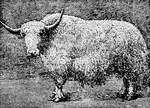Clipart tagged: ‘wild yak’

Yak
"Yak is a species of ox from the mountainous regions of Tibet. There are two races: the wild yak, generally…

"Yak is a species of ox from the mountainous regions of Tibet. There are two races: the wild yak, generally…